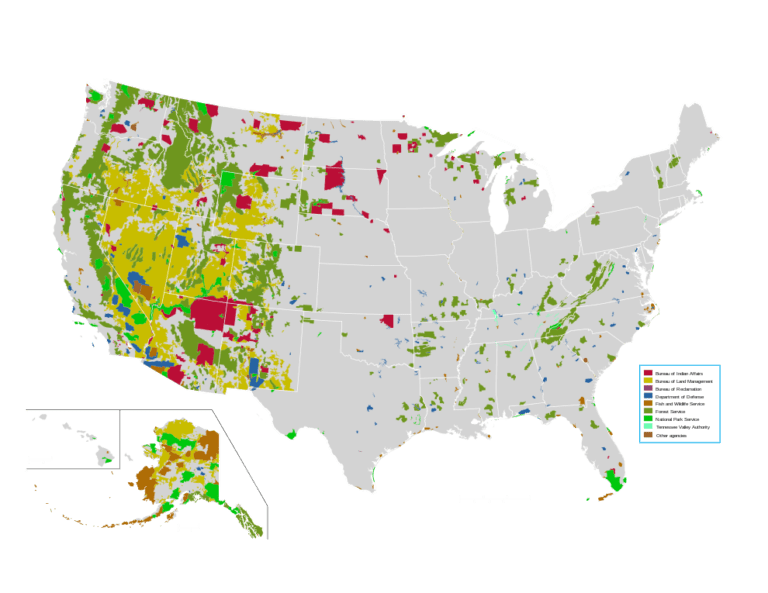In 1910, the largest fire in American history ripped through Montana, Idaho, and Washington. It torched over 3 million acres (4,700 sq mi) swallowing Western boom towns, mines, and communities. While the country had recently begun protecting national parks, this massive fire led to greater appreciation and protection of national forests.1
For many, the Smokey Bear fire danger signs often present the most visible image of what threatens our federal lands. News of fires dancing up and down the West burn across our television and tablet screens. While the fires are certainly dangerous, the question remains: what’s most threatening to federal public lands?
In Part I, we explored what makes our public lands so great. Now in Part II, let’s take a look at what’s endangering them. The greatest threats to public lands can be broken into three categories: direct human impact, indirect human impact, and neglect.
****
Direct human impact
Some of the most visible signs of human impact on public lands come from visitors/users themselves. The continuing increase of visitors to public lands has put a massive strain on natural resources. While visitors create necessary revenue for federal lands, the incredible number has begun degrading natural resources and detracting from visitor experiences. One might think of simple things like littering (which has an incredibly negative impact), but other issues arise from use. For example, hiking off-trail in sensitive areas destroys fragile vegetation and creates massive erosion through the destruction of specimen like cryptobiotic crusts.
Even staying on trails has an impact. Cars, bikers, hikers, and horseback riders alike typically stay on trails in order to reduce damage, but they still degrade lands by creating noise, moving invasive species, and dramatically impacting the behavior and lives of animals. Trails typically go through beautiful areas for our enjoyment, but they also dislocate animals that inhabit that area. Animals that do stay often become too comfortable with human presence, putting them in danger. Every year, hundreds of large mammals are euthanized or killed because of car collisions, interactions with humans at campgrounds, or crazy stories like people thinking a baby bison is cold and trying to put it in their car.
Perhaps the greatest direct threat to public lands is encroaching development. This typically comes in the form of semi-urban areas near rural public lands. However, it also includes farming, ranching, mining, and logging. There are over 11,600 inholdings in national parks, or property that was owned prior to the establishment or expansion of the park and is now located inside the current park boundaries. Many of these landowners have begun developing this property.
Other developments have been spreading just outside the parks. Towns like Jackson Hole, WY and Pigeon Forge, TN have gone from quaint tourist stops to booming urban centers, frequently accommodating guests who spend their days on neighboring public lands. In Colorado, once-sleepy mining towns like Aspen have exploded into ski resort meccas, increasing their population over 600% since 1950. While much of this development is for commercial use, a great deal is also used for oil & gas drilling, logging, and mining for mineral resources.
Encroaching development threatens public lands because public lands are not free-standing ecosystems. These ecosystems rely on their surrounding areas. The massive growth of nearby communities and resource extraction projects interrupts everything from water use, to mating seasons, to wildlife corridors for broad-range animals like wolves, mountain lions, or elk.
The damaging effects of human impact are wide-ranging, both individual and systematic. They are the most visible impacts on public lands, threatening the life that calls them home. The direct impacts, however, are just the beginning.
Indirect human impact
Indirect human impact includes broad and widespread human activity that ultimately impacts public lands. The far-and-away greatest indirect impact is climate change, itself bringing on a myriad of other challenges and dangers. The high visibility of direct impact like trail damage or littering more easily garners public reaction and engagement. However, indirect issues can be far more insidious because they take longer to show their damage or have no direct fault. For example, who is responsible for the disappearing glaciers at Glacier National Park?
Climate change presents one of the greatest challenges to our world today. It impacts every person and ecosystem. Public lands – often the home of sensitive species – face massive challenges responding to climate change. What will erratic weather do to sensitive areas like Yosemite, Everglades, or Denali? Climate change’s impact on public lands could be truly catastrophic, damaging ecosystems, visitor experiences, and the lives of animals. Large, typically resilient mammals like bison are even experiencing physical changes in response to blazing summers and warm winters.
Regarding forest fires, as stated in both parts of this series, they are absolutely vital for healthy forests. Trees like the giant sequoia cannot exist without fire. In 1988, fires sprinted across Yellowstone, spurred by drought, high amounts of tinder, strong winds, and a hot summer. Close to 800,000 acres (about 36% of the park) caught fire. While these blazes were infamous for their destruction, they also brought new life and hope.
While some forest fires are caused by neglect or recklessness (e.g. cigarettes or illicit campfires), others come from decades of poor management and fire suppression. And now things are getting worse. Climate change has been initiating more devastating fires through an increase in droughts, excessive temperatures, and dry climates. Each of these contributes to the perfect conditions for uncontrollable fires. When fires grow too large or viciously hot, they can annihilate chances of regeneration. Rather than offering the typical advantages of a forest fire (like opening the cones of lodgepole pines or getting rid of built-up plant debris), extreme forest fires reduce everything in their path to ash, leading to other negative secondary impacts like flooding and erosion.
Wandering off the trail directly damages lands, but at least this problem is easily spotted and has clear remedies. The large-scale, indirect impacts from climate change are all the more insidious because they are less visible, easily attributed to somebody else, and too readily dismissed.
Neglect
While many of the dangers to public lands stem from direct and indirect human impact, one of the greatest threats facing public lands is our neglect. Federal land agencies face a massive backlog of deferred maintenance, largely due to lack of funding. Highly visited areas like Yosemite, Yellowstone, or the Great Smoky Mountains can generate revenue to tackle some of their maintenance needs. But what about less-visited parks that nonetheless protect vital ecosystems, like Colorado’s Black Canyon of the Gunnison? They’re part of an almost $12b maintenance backlog.
One result of this funding shortage is that it forces federal-to-state or federal-to-private land sales. These sales are promoted in the name of small government, but primarily emerge out of a desire to open areas to ranching, drilling, and mining. Both large and small-scale landowners are hoping to open more federal lands to resource extraction.
Perhaps you remember the Bundy standoffs in both Oregon and Nevada. These standoffs came from a general distrust of federal government, a demand for self-determination, and an effort to privatize public lands, especially by the Bureau of Land Management (BLM). Although the Bundy’s played a role, the standoffs in part came about due to neglect and underfunding for the BLM. For branches like the BLM, resource extraction is part of their mandate. However, privatizing these lands removes them from the accountability and responsibility of the American public. Even turning federal lands over to the state drastically reduces oversight, management, and access for public enjoyment.
Whether it be deferred maintenance or privatization for resource extraction, neglect threatens the spirit of democracy and responsibility encapsulated by public lands.
****
The biggest threats to America’s public lands fall into three main categories: direct human impact, indirect human impact, and neglect. Each of these bears its own unique dangers. The direct impact is easily seen, thus often the most acted upon. Indirect impacts are more easily overlooked, as the blame gets spread around and no action is taken. The neglect of federal lands threatens to push them into state or private hands, drastically cutting recreational access and leading to greater environmental damage. Each of these dangerous categories threatens our federal public lands and carries its challenges.
Let us know in the comments what you think are the biggest threats, and what we need to do to protect these lands. Be sure to check back for Part III on how you can get involved!
- For those wondering the difference between a national park and forest, check out this. ↩



